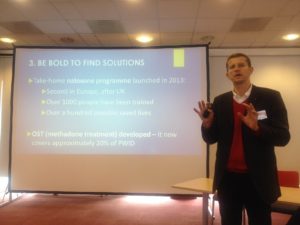
The evidence is unequivocal: harm reduction saves lives and money. Yet NGOs have long fought an uphill battle to get funding for needle exchanges and opioid substitution therapy. In central and eastern Europe, that struggle has gotten much worse in the last couple of years after the Global Fund – the major funder of harm reduction programs in this sub-region – withdrew support.
Last week, NGO representatives from 9 central and eastern European countries gathered in Budapest to share strategies for securing sustainable funding for harm reduction. The Eurasian Harm Reduction Network and the Open Society Foundations brought them together for the three-day workshop as part of Harm Reduction Works!, an EU initiative to better equip civil society to advocate for more funding.

Key strategies for increasing government funding ranged from litigation and watchdogging, to lobbying ministers and legislators, to media campaigns and public mobilization. Although no secret funding shortcuts were revealed, there was good advice aplenty. And the real value of the workshop lay in compelling participants to sit down, brainstorm with national colleagues, and do some of the things everyone knows they should do but rarely get the time to do: establish priorities for budget advocacy, diagram the relationships among key governmental actors and develop an advocacy action plan.
Many of the participants remained for a seminar the next day organized by Harm Reduction International. It was particularly inspiring to hear the Czech director of drug policy and an Estonian MP (former Minister of Justice) discuss how their countries are committed to harm reduction, and why they find partnerships with civil society invaluable.
These interviews, part of the European Joint Action HA-REACT’s work on sustainable funding of harm reduction services, will appear here on the HMAP section of the “On Health” blog in the course of the coming months.
But the situation varies a great deal, of course, from country to country. To shed light on what people have learned in their efforts to secure funding for harm reduction, I spoke to a diverse group of participants in Budapest – chiefly NGO representatives, but also several regional experts and one government official. These interviews, part of the European Joint Action HA-REACT’s work on sustainable funding of harm reduction services, will appear here on the HMAP section of the “On Health” blog in the course of the coming months. They’ll focus on what has proven most effective in these countries – and what new opportunities lie ahead, like the provision of hepatitis C treatment as countries scale up in line with the new WHO Global Health Sector Strategy on Hepatitis. Stay tuned!
About HA-REACT
HA-REACT – short for the Joint Action on HIV and Co-Infection Prevention and Harm Reduction – addresses knowledge gaps in the prevention of HIV and HIV co-infections, including TB and viral hepatitis, among people who inject drugs (PWID). With primary funding from the European Union, HA-REACT is being implemented by 23 partners in 18 member states. Another 14 collaborating partners include the European Centre for Disease Prevention and Control (ECDC) and the European Monitoring Centre for Drugs and Drug Addiction (EMCDDA).
The project aims to contribute to the elimination of HIV and reduction of TB and viral hepatitis among PWID in the EU by 2020 and focuses on member states with gaps in effective and evidence-informed interventions. The project will also encourage the implementation of comprehensive harm reduction programs in all EU member states as an essential strategy for improving prevention and treatment of HIV, TB and viral hepatitis. Further information about HA-REACT is available at: www.hareact.eu
Hepatology, Medicine and Policy is now accepting submissions on this and related issues. For more information, visit: www.hmap.biomedcentral.com.
Comments